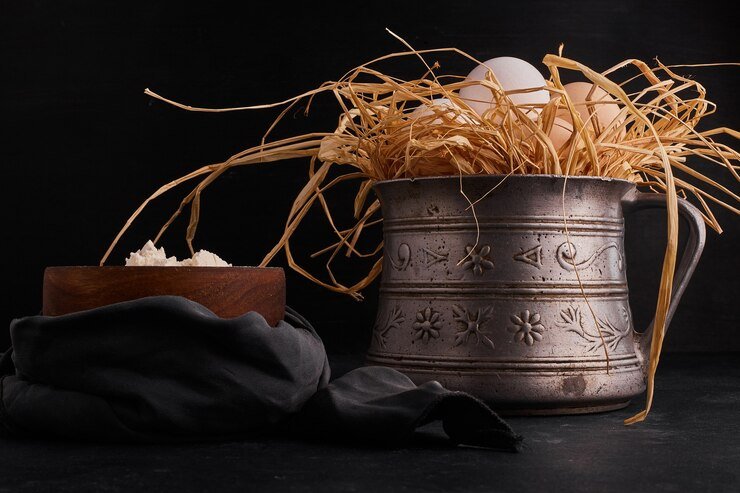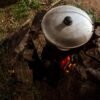Cooking in a Roman Kitchen
Close your eyes for a moment and imagine stepping into a Roman kitchen nearly 2,000 years ago. The air smells of garlic, herbs, and olive oil sizzling over an open hearth. You see bronze pans hanging from hooks, clay jars stacked neatly, and long-handled spoons resting by a bubbling pot. Servants move about, grinding spices with stone mortars, while bread bakes in a clay oven.
Archaeology has opened a window into this world, allowing us to touch, see, and even replicate the Roman cooking utensils that once brought meals to life. Surprisingly, many of these tools don’t look so different from what we use today. In fact, the Romans’ kitchens reveal just how inventive and sophisticated their approach to food really was.
Why This Topic Matters
We often picture Romans feasting on banquets of roasted boar, grapes, and wine, but the real story lies in how they cooked their everyday meals. Archaeological digs in Pompeii, Herculaneum, and Roman villas across Europe have uncovered utensils that show us not just what Romans ate, but how they prepared it.
Understanding these tools isn’t only about history. It tells us how cultures evolve, how technology changes kitchens, and how food traditions connect across centuries. When you step back, it feels like exploring Roman cooking utensils is also exploring the roots of European cuisine.
Everyday Roman Cooking Utensils
Mortar and Pestle (Mortarium)
One of the most common finds in Roman kitchens is the mortar and pestle. Romans ground spices, herbs, nuts, and even fish into pastes. The mortarium, a large mortar often studded with grit inside, helped prepare sauces and condiments. Roman recipes recorded by Apicius—like garum-based dressings—often began here.
Bronze and Iron Pans (Patera and Sartago)
Romans loved frying and simmering. Archaeologists have uncovered bronze frying pans with handles, similar to today’s skillets. Some had elegant designs, showing that cooking could be both practical and artistic.
Cooking Pots (Olla)
The olla was a round, wide-mouthed clay or bronze pot used for stews, soups, and boiling. Placed directly into the hearth or on a tripod over coals, it was the workhorse of the Roman kitchen.
Ladles and Spoons (Cochlear)
Romans didn’t just eat with spoons—they cooked with them. Long-handled bronze ladles stirred soups, while smaller spoons scooped sauces. Some cochlear spoons even had pointed ends, perfect for spearing shellfish or olives.
Knives and Cleavers
Bronze and iron knives with wooden handles were used for chopping meat and vegetables. Some were specialized for butchering, others for slicing bread or carving roasts.
Graters (Rasoria)
Romans grated cheese, garlic, and sometimes even nuts. Bronze graters found in Pompeii look strikingly similar to the ones you might have in your kitchen drawer.
Strainers (Colum)
Wine was often full of sediment, so Romans used strainers to filter it before drinking. They also used strainers for sauces, making sure their dressings had smooth, refined textures.
Specialized Utensils for Roman Cuisine
Romans loved variety, and their utensils reflected their culinary creativity.
-
Tripods and Braziers: Portable cooking stands allowed pots to sit above hot coals. These made kitchens flexible, turning any courtyard into a cooking space.
-
Bread Molds: Romans were avid bakers, and molds shaped bread loaves into recognizable forms. Bakeries in Pompeii had rows of bread stamped with marks of ownership.
-
Fish Sauce Tools: Since garum (fermented fish sauce) was central to Roman cooking, tools for straining and storing it were common.
-
Amphorae: Large clay jars stored oil, wine, grains, and sauces. Their pointed bottoms allowed easy stacking in kitchens and ships, fueling Rome’s food trade.
What Archaeology Reveals About Roman Kitchens
Sites like Pompeii and Herculaneum, frozen in time by volcanic ash, are treasure troves of Roman utensils. Archaeologists have uncovered intact pots, pans, and even carbonized loaves of bread.
These discoveries show us that Roman kitchens were surprisingly advanced:
-
Diverse Materials: Romans used clay for slow cooking, bronze for durability, and iron for strength.
-
Design and Function: Handles were crafted for easy grip, lids for slow simmering, and spouts for pouring.
-
Urban Kitchens: Many Roman houses had small hearths or braziers, while wealthy villas included larger ovens and more elaborate equipment.
It’s fascinating to realize that many of our “modern” tools, like frying pans, ladles, and graters, already existed in Roman times.
Comparison: Roman vs. Modern Cooking Tools
| Tool | Roman Version | Modern Equivalent | Similarities / Differences |
|---|---|---|---|
| Mortarium | Large grit-lined mortar | Mortar and pestle | Nearly identical in use |
| Olla | Clay or bronze stew pot | Dutch oven/stock pot | Same purpose, new materials |
| Patera / Sartago | Bronze frying pan | Skillet or frying pan | Shape unchanged |
| Cochlear | Spoon with pointed end | Soup spoon/cocktail fork | Multipurpose design |
| Colum | Bronze strainer | Metal strainer/sieve | Functionally identical |
| Rasoria | Bronze grater | Cheese grater | Very similar |
| Amphora | Clay storage jar | Glass or plastic containers | Materials modernized |
When you compare them side by side, it’s striking how much of today’s kitchen still echoes the Roman design.
My Experience: Cooking Roman-Style
A few years ago, I attended a historical cooking demonstration where archaeologists recreated Roman dishes using replicas of ancient utensils. Watching olive oil sizzle in a bronze pan, hearing the scrape of a mortar and pestle crushing herbs, and tasting bread baked in a clay oven it felt like stepping back in time.
The dish that surprised me most was a simple stew of lentils, onions, and herbs cooked in a clay olla. The flavor was rich and earthy, nothing fancy but deeply comforting. It made me realize how little has changed in the way we seek warmth and satisfaction from food.
Expert Insights
Smithsonian Magazine has documented how utensils found in Pompeii reveal the daily eating habits of ordinary Romans, not just the elite. National Geographic notes that Roman innovation in food storage, like amphorae, helped feed an empire that stretched across continents.
Cultural historians also emphasize that Roman tools weren’t just practical—they reflected status. A wealthy Roman might have bronze and silver utensils, while a poor household relied on clay and iron. Yet the core tools remained the same, showing that food united everyone, regardless of class.
Why Roman Cooking Utensils Still Matter
Studying Roman utensils isn’t just about curiosity. It reminds us that kitchens are the heart of civilization. Romans left behind aqueducts and roads, but they also left behind spoons, pots, and pans—evidence that food was central to life.
When you step back, it feels like these tools connect us directly to the past. Every time you stir soup with a ladle or grate cheese over pasta, you’re echoing gestures that Romans once made thousands of years ago.
FAQs: Roman Cooking Utensils
Q1: What was the most common cooking utensil in Rome?
The olla (clay cooking pot) was found in almost every Roman household, used for stews and soups.
Q2: Did Romans really use graters and strainers?
Yes. Archaeology shows graters for cheese and garlic, and strainers for wine and sauces.
Q3: Were Roman utensils only for the rich?
No. While elites had bronze and silver versions, poorer families used clay and iron, but the designs were similar.
Q4: Can we cook with replicas today?
Yes. Many museums and experimental archaeologists recreate Roman utensils for demonstrations, and the results are surprisingly practical.
Final Thoughts: Tools That Tell a Story
The Roman cooking utensils uncovered by archaeologists aren’t just dusty artifacts. They’re storytellers. They whisper about family meals, bustling kitchens, and the simple joy of sharing bread and wine.
Here’s what this really means: civilizations rise and fall, but the tools of cooking endure. The same way we reach for a frying pan or ladle today, Romans once did too. By studying their kitchens, we don’t just learn about their food—we learn about ourselves.
So the next time you stir, grate, or strain, pause for a moment. You may be closer to ancient Rome than you think.



